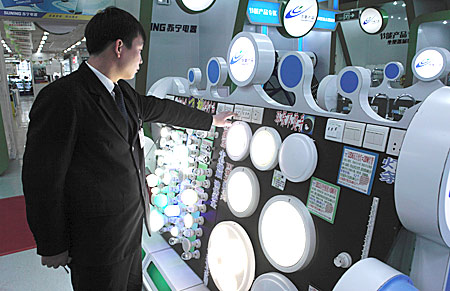Nation to curb overcapacity, develop low-carbon economy
China is making concrete steps in pushing forward with its low-carbon economy by curbing overcapacity on one hand and boosting strategic emerging industries on the other.
 |
|
An employee looks at energy-saving lights at a Suning appliance store in the Anzhen community in Beijing on Sunday. [China Daily] |
At a press conference held here on Wednesday, Li Ningning, a senior official from the National Development and Reform Commission (NDRC), the country's top economic planner, said the overcapacity problem in a few industrial sectors such as coal chemical industry and vitamin C must be tackled.
China is the biggest producer of coal chemical industry. From January to November this year, China produced 314 million tons of coke, up 8.2 percent year on year, Li said.
In 2009, production capacity of coke expanded by 30 million tons while the export down 96 percent from a year earlier to 480,000 tons. Utilization rate of the capacity was 80 percent in 2008, he said.
"China is a country comparatively rich of coal while lack of oil and gas, the mature technology and low investment threshold in the coal chemical industry seems conducive to the investment," said Li.
Restructuring of the coal chemical industry involves in eliminating outdated coal chemical production capacity, supporting technological innovations and strengthening policy guidance, according to Yuan Longhua, an official from the Ministry of Industry and Information Technology.
Wang Jian, secretary general of China Society of Macroeconomics, had said in an article published by the Xinhua-run Outlook Weekly that 17 industries in China were faced with excessive capacity in 2008, rising from 11 in 2005. And the number of industries with excessive capacity is still rising, Wang added.
Chinese Premier Wen Jiabao told Xinhua on Sunday that overcapacity was a result of the long-existing problem of an imbalanced economic structure in China.
"To resolve the problem of overcapacity, the most important thing is to take economic, environmental, legal and, if necessary, administrative measures to eliminate backward capacity and, in particular, restrict the development of energy-consuming and polluting industries with excess capacity," Wen said.
BOOSTING LOW-EMISSION INDUSTRIES
Also at the press conference on Wednesday, Shi Lishan, another official with the NDRC, said the government needed to guide the development of high-tech industries such as wind and solar power equipment manufacturing as China rushed to build a low-carbon economy.
Earlier this month, Premier Wen had listed seven high-tech emerging industries as new energy, energy-saving and environmental protection, electric vehicles, new materials, information industry, new medicine and pharmacology, as well as biological breeding.
Development of emerging high-tech industries could not only bring about a low-carbon economy, but also help China tide over the financial crisis.
"The key to conquer the global economic crisis lies in people's wisdom and the power of science and technology," Wen said.
Boosting low-carbon technologies was crucial for the transformation of the nation's economy, Wen said.
New energy, energy-saving, environmental protection and electric vehicles industries were on the government's priorities among the seven emerging industries that needed particular attention.
By the end of 2008, China's energy-saving and environmental protection industries totalled 1.55 trillion yuan (227 billion U.S. dollars), accounting for 5.17 percent of the country's GDP, according to the NDRC.
He Bingguang, another NDRC official, forecast at a forum on the low-carbon economy held in Beijing last week that due to government policies the two industries would account for 7 to 8 percent of China's gross domestic product (GDP) by 2015.
In fact, financing of low-carbon industries has been part of the government's stimulus package.
Liu Mingkang, chairman of the China Banking Regulatory Commission, said that Chinese banks would continue to play positive roles in energy conservation and environmental protection, as well as helping adjusting the economy's structure.
"Banks should be part of the concerted efforts to make a low-carbon economy," he said at a financial forum here last week.
Liu said to control risks, banks should create more low-carbon financial products to benefit the "green economy."
Besides shutting down high emission enterprises, environmental experts have predicted increased investment on technological innovation, energy-saving and environmental protection, especially in the field of new energy.
China would stand on its own feet to develop low-carbon technologies, predicted Jin Jiaman, head of the Global Environmental Institute.
"China must develop in a low-carbon way not just to be part of the global trend but rather because it's an inevitable choice given the current economic conditions and future prospects," Jin said.
 0 Comments
0 Comments






